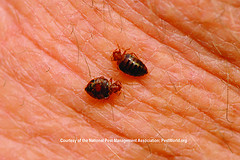
flickr.com/56881272@N02
When we tuck in for the night, of course, the last thing we expect is to have a stranger in the bed. The truth is, strangers can indeed lurk in the bedding, causing the unsuspecting victim to wake up irritable and itchy.
Bed bugs are an unpleasant truth of life. These insects can be found virtually the world over; in rural areas and cities, from inner-city neighbourhoods to ivory towers.
The bed bug is identified in scientific circles as Cimex lectularius. They are one small branch in that immense family tree famous as Insecta. If ever a time came when all of the creatures of the Earth were eliminated, the pests would be last standing. With their flexibility and resilience, insects would be left to occupy the planet long after the humans and mammals had become extinct. This is why many insects, as well as bed bugs, can be so hard to exterminate.
How to Locate a Bed Bug
They are so small that it can be hard to spot them. A magnifying lens or glass is required to take a good look. When viewed from the top (the best manner to view them if you absolutely must take a closer look), bed bugs appear to be quite flat. Bed bugs in North America are typically deep brown in color. However, in Europe and other parts of the world these insects can range from white to a creamy white color. The most unpleasant fact about bed bugs is that they nourish on human blood. Soon after feeding, the insects will have deep red or black masses in their stomach areas, and will appear to be bloated.
How Bed Bugs Feed
Like their distant relatives the Mosquitoes, bed bugs have tiny beaks. Commonly, they use these beaks to pierce through the host’s skin. Once through the skin, bed bugs will suck and sip the blood. The good news is that because of their extremely very small size, bed bugs will barely take a fourth of a milliliter of blood from you. The bites will leave small red marks that may bulge within a few hours. The affected area can also cause discomfort and itching to the victim.
Extermination
It’s not easy to eliminate bed bugs. They are very tiny to swat, and an infestation can bring a large number of these parasites to your boudoir. While it would be possible to catch and watch and squish them one by one, that would be a tedious and time-consuming affair. There are easier steps.
It is possible to annihilate bed bugs with an application of insecticides or pesticides, but this chemical application will surely pose a danger to yourself, your family and any pets in your home. While human extermination due to pesticide use is unlikely, the chemicals can cause harsh reactions. Employ a credible and professional pest control company, just to be on the safe side. They will understand the bugs and can offer your best course of defense.
Prevention
It’s been claimed that an ounce of prevention is worth more than a pound of cure. In other words, it’s a lot easier to avoid bud bugs from arriving than it is to persuade them to leave. Hygiene can play an essential role in preventing an infestation. Wash pillows and bedclothes regularly and dry them in a hot dryer. Vacuuming the mattress can also aid.
When you travel, use common sense and realize that bed bugs are definitely a threat. If you do encounter them along your journey, you need to learn that they may hitch a ride along with you. While bed bugs do not opt humans as their primary means of transport, they are known to travel among clothing or even baggage. If you think that your belongings may have become infested, find a coin laundry or a laundry service and clean everything before moving on. You may also want to have your luggage cleaned before packing it away at home. This may look extreme, but it’s much better than experiencing a home invasion.
There’s nothing worse than an unwanted bed guest, specifically the six-legged variety. Keep these facts in mind when you turn out the lights, and you can wake up clean, refreshed — and at peace.
Tagged with: bed bugs control • pests control
Filed under: Bed Bugs